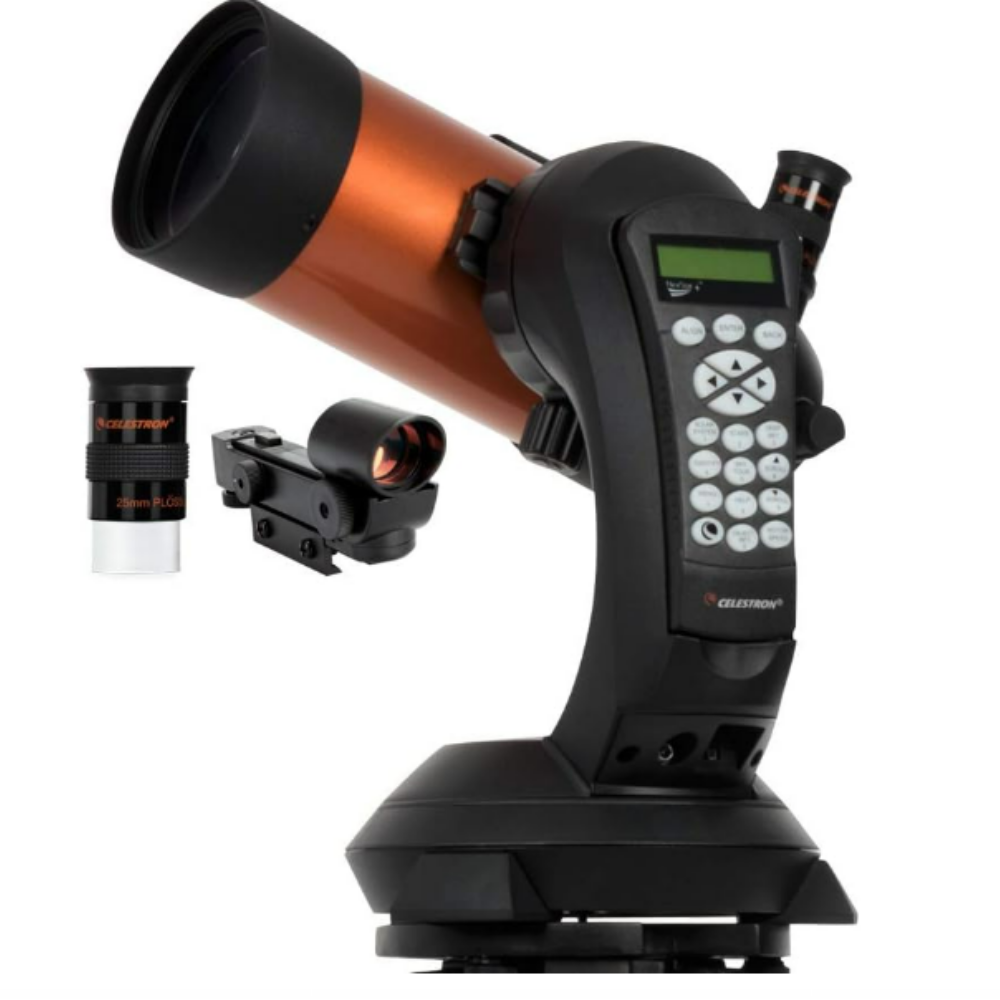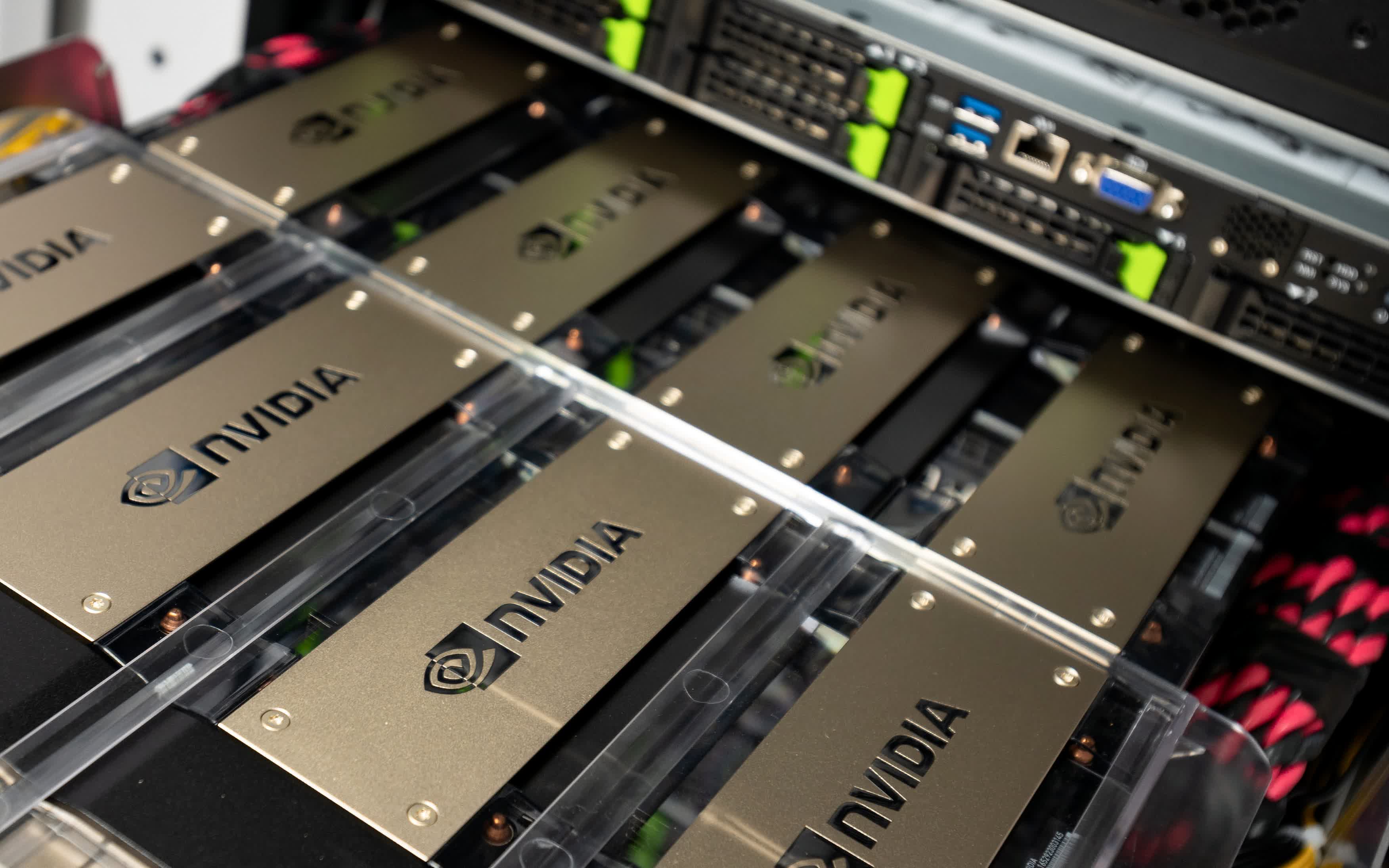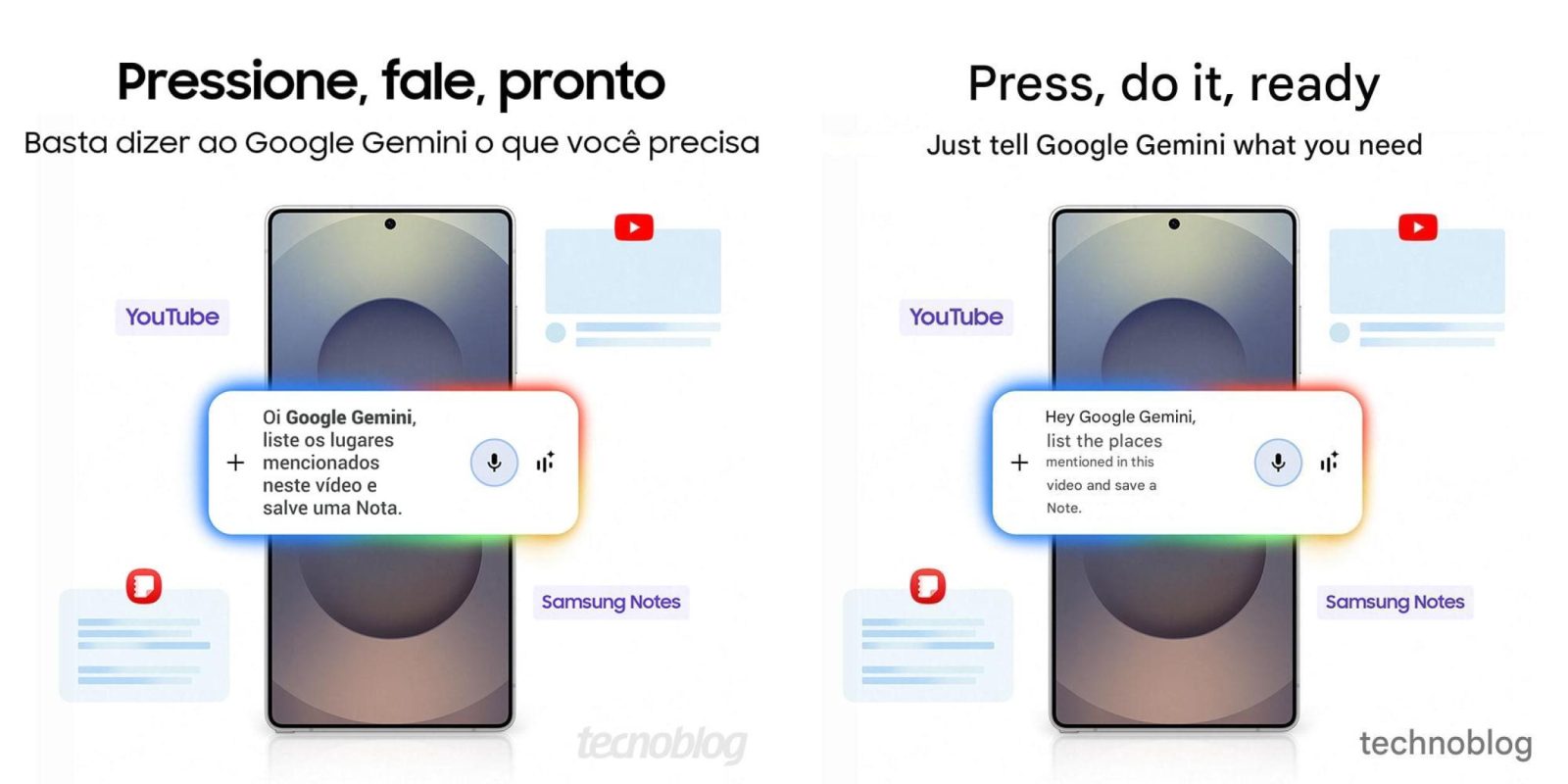By Jonathan AmosScience correspondent
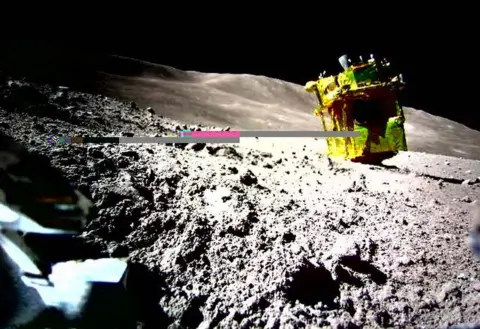 JAXAThe Slim lander may yet come back to life if its solar cells can be made to workJapan’s Moon lander ended up landing with its nose down on the lunar surface. The first image of the stricken Slim spacecraft shows it rotated 90 degrees from how it should have come to rest. This will help explain the difficulties it has had in generating the electricity needed to operate. The image was captured by the small baseball-sized robot called Sora-Q that was ejected from Slim moments before touchdown last Saturday. “An abnormality in the main engine affected the landing attitude of the spacecraft,” the Japanese space agency Jaxa said in a statement. It seems one of the two big thrusters on Slim (Smart Lander for Investigating Moon) stopped working during the descent.
JAXAThe Slim lander may yet come back to life if its solar cells can be made to workJapan’s Moon lander ended up landing with its nose down on the lunar surface. The first image of the stricken Slim spacecraft shows it rotated 90 degrees from how it should have come to rest. This will help explain the difficulties it has had in generating the electricity needed to operate. The image was captured by the small baseball-sized robot called Sora-Q that was ejected from Slim moments before touchdown last Saturday. “An abnormality in the main engine affected the landing attitude of the spacecraft,” the Japanese space agency Jaxa said in a statement. It seems one of the two big thrusters on Slim (Smart Lander for Investigating Moon) stopped working during the descent.
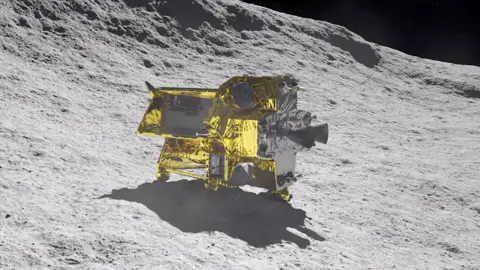 JaxaAn artist’s impression of the orientation the Slim spacecraft should have adoptedTo transmit the picture to Earth, Sora-Q first had to send it to a second ejected roving robot, Lunar Excursion Vehicle 1, or Lev-1. This hopping robot has radio equipment that can contact mission control independently of Slim. The lander itself was shut down three hours after arrival because it could not get its solar cells to work. With the battery rapidly draining, Jaxa officials took the decision to hibernate Slim. Their assumption – which seems to be borne out by the Sora-Q image – is that the main spacecraft is orientated in a way that prevents the solar cells from seeing the Sun. The hope is to wake Slim when lighting angles change at its landing location.
JaxaAn artist’s impression of the orientation the Slim spacecraft should have adoptedTo transmit the picture to Earth, Sora-Q first had to send it to a second ejected roving robot, Lunar Excursion Vehicle 1, or Lev-1. This hopping robot has radio equipment that can contact mission control independently of Slim. The lander itself was shut down three hours after arrival because it could not get its solar cells to work. With the battery rapidly draining, Jaxa officials took the decision to hibernate Slim. Their assumption – which seems to be borne out by the Sora-Q image – is that the main spacecraft is orientated in a way that prevents the solar cells from seeing the Sun. The hope is to wake Slim when lighting angles change at its landing location.
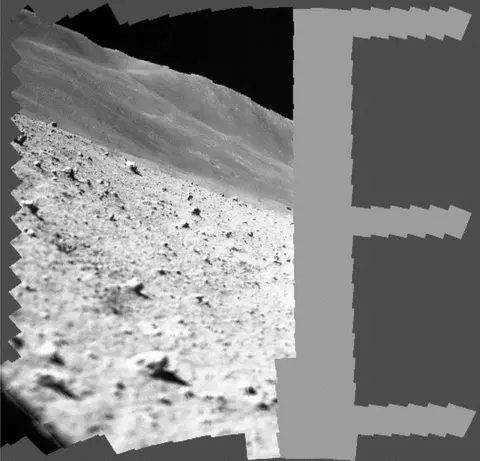 JAXAThis mosaic from Slim’s on-board camera comprises 257 individual viewsBefore hibernation, controllers were able to pull down a series of pictures of the surface taken by its on-board infrared camera. These show the spacecraft to be on a slope, surrounded by small rocks. Slim’s landing location is at the edge of an equatorial crater known as Shioli. The landing on Saturday at 00:20, Japan standard time (15:20 GMT), made Jaxa only the fifth national space agency to achieve a soft touchdown on the Moon – after the US, the former Soviet Union, China and India. Statistically, it’s proved very hard to put down softly on the lunar surface. Only about a half of all attempts have succeeded.
JAXAThis mosaic from Slim’s on-board camera comprises 257 individual viewsBefore hibernation, controllers were able to pull down a series of pictures of the surface taken by its on-board infrared camera. These show the spacecraft to be on a slope, surrounded by small rocks. Slim’s landing location is at the edge of an equatorial crater known as Shioli. The landing on Saturday at 00:20, Japan standard time (15:20 GMT), made Jaxa only the fifth national space agency to achieve a soft touchdown on the Moon – after the US, the former Soviet Union, China and India. Statistically, it’s proved very hard to put down softly on the lunar surface. Only about a half of all attempts have succeeded.
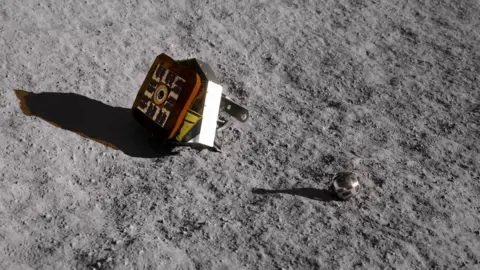 JaxaArtwork: The hopper, Lev-1 (L) and a rolling, shape-shifting Sora-Q (R)Jaxa put its faith in new precision-navigation technologies. The lander’s onboard computer used rapid image processing and crater mapping to avoid hazards to reach its touchdown point. Engineers had wanted to get within 100m (330ft) of their targeted location. This was achieved. “Analysis of the data acquired before shutting down the power confirmed that Slim had reached the Moon’s surface approximately 55m east of the original target landing site,” said Jaxa, adding that the onboard computer had also taken a decision in the final moments of descent to move the craft to one side to avoid obstacles. This will delight officials, as will the success of the two rovers. Not only did Sora-Q move on the lunar surface and take its picture, but Lev-1 also managed to hop. Like Slim, Lev-1 has also powered down. “The accomplishment of Lev-1’s leaping movements on the lunar surface, inter-robot communication between Lev-1 and Sora-Q, and fully autonomous operations represent ground-breaking achievement. It would be regarded as a valuable technology demonstration for future lunar explorations, and the acquired knowledge and experience will be applied in upcoming missions,” the agency said.
JaxaArtwork: The hopper, Lev-1 (L) and a rolling, shape-shifting Sora-Q (R)Jaxa put its faith in new precision-navigation technologies. The lander’s onboard computer used rapid image processing and crater mapping to avoid hazards to reach its touchdown point. Engineers had wanted to get within 100m (330ft) of their targeted location. This was achieved. “Analysis of the data acquired before shutting down the power confirmed that Slim had reached the Moon’s surface approximately 55m east of the original target landing site,” said Jaxa, adding that the onboard computer had also taken a decision in the final moments of descent to move the craft to one side to avoid obstacles. This will delight officials, as will the success of the two rovers. Not only did Sora-Q move on the lunar surface and take its picture, but Lev-1 also managed to hop. Like Slim, Lev-1 has also powered down. “The accomplishment of Lev-1’s leaping movements on the lunar surface, inter-robot communication between Lev-1 and Sora-Q, and fully autonomous operations represent ground-breaking achievement. It would be regarded as a valuable technology demonstration for future lunar explorations, and the acquired knowledge and experience will be applied in upcoming missions,” the agency said.
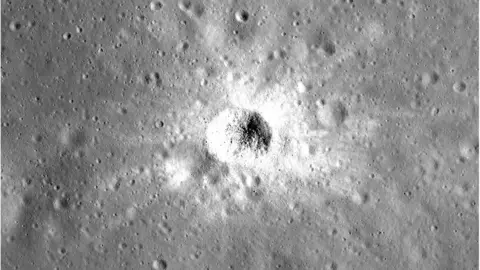 NASA/LROThe targeted landing site was on the slopes approaching Shioli Crater, which is just south of the Moon’s equatorCopyright 2024 BBC. All rights reserved. The BBC is not responsible for the content of external sites. Read about our approach to external linking.Beta Terms By using the Beta Site, you agree that such use is at your own risk and you know that the Beta Site may include known or unknown bugs or errors, that we have no obligation to make this Beta Site available with or without charge for any period of time, nor to make it available at all, and that nothing in these Beta Terms or your use of the Beta Site creates any employment relationship between you and us. The Beta Site is provided on an “as is” and “as available” basis and we make no warranty to you of any kind, express or implied. In case of conflict between these Beta Terms and the BBC Terms of Use these Beta Terms shall prevail.
NASA/LROThe targeted landing site was on the slopes approaching Shioli Crater, which is just south of the Moon’s equatorCopyright 2024 BBC. All rights reserved. The BBC is not responsible for the content of external sites. Read about our approach to external linking.Beta Terms By using the Beta Site, you agree that such use is at your own risk and you know that the Beta Site may include known or unknown bugs or errors, that we have no obligation to make this Beta Site available with or without charge for any period of time, nor to make it available at all, and that nothing in these Beta Terms or your use of the Beta Site creates any employment relationship between you and us. The Beta Site is provided on an “as is” and “as available” basis and we make no warranty to you of any kind, express or implied. In case of conflict between these Beta Terms and the BBC Terms of Use these Beta Terms shall prevail.
Stricken Japanese Moon mission landed with nose down



